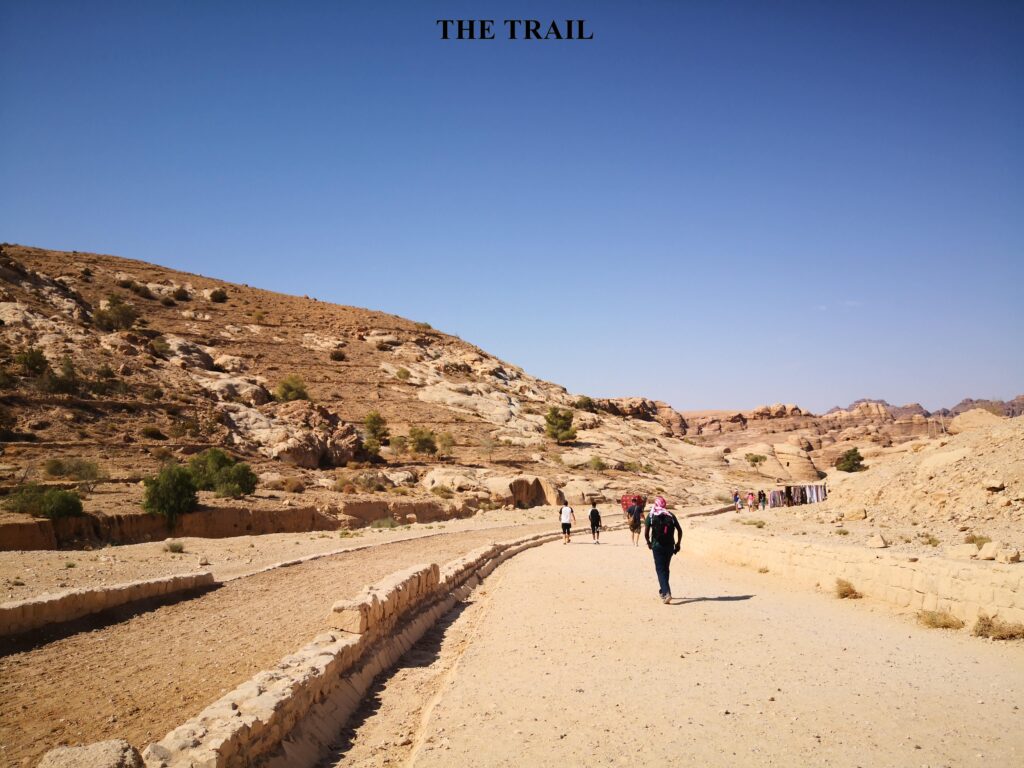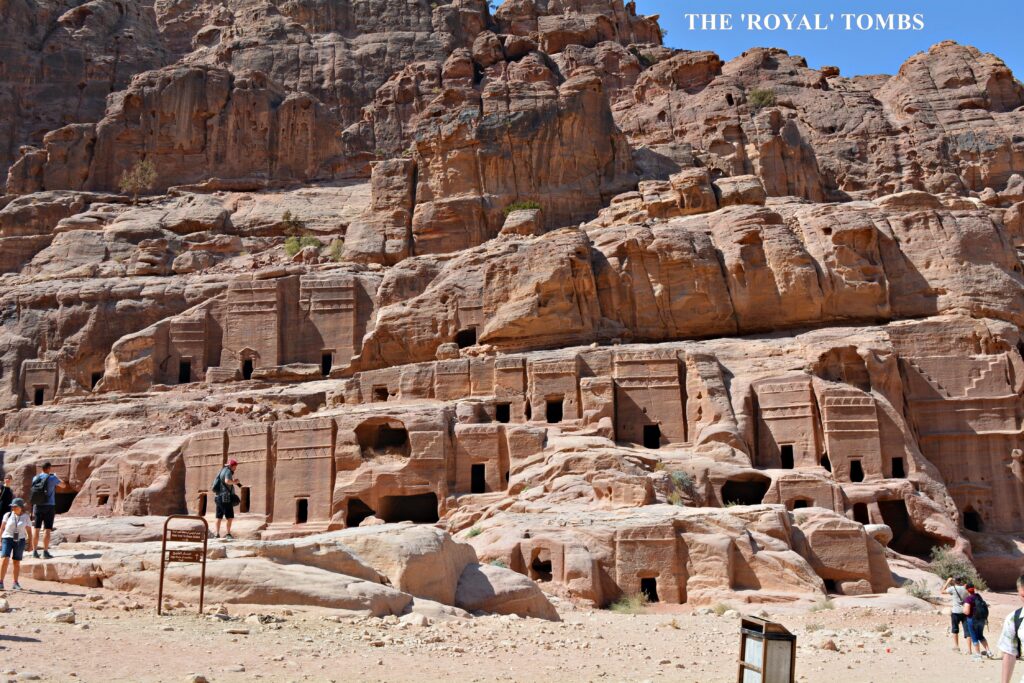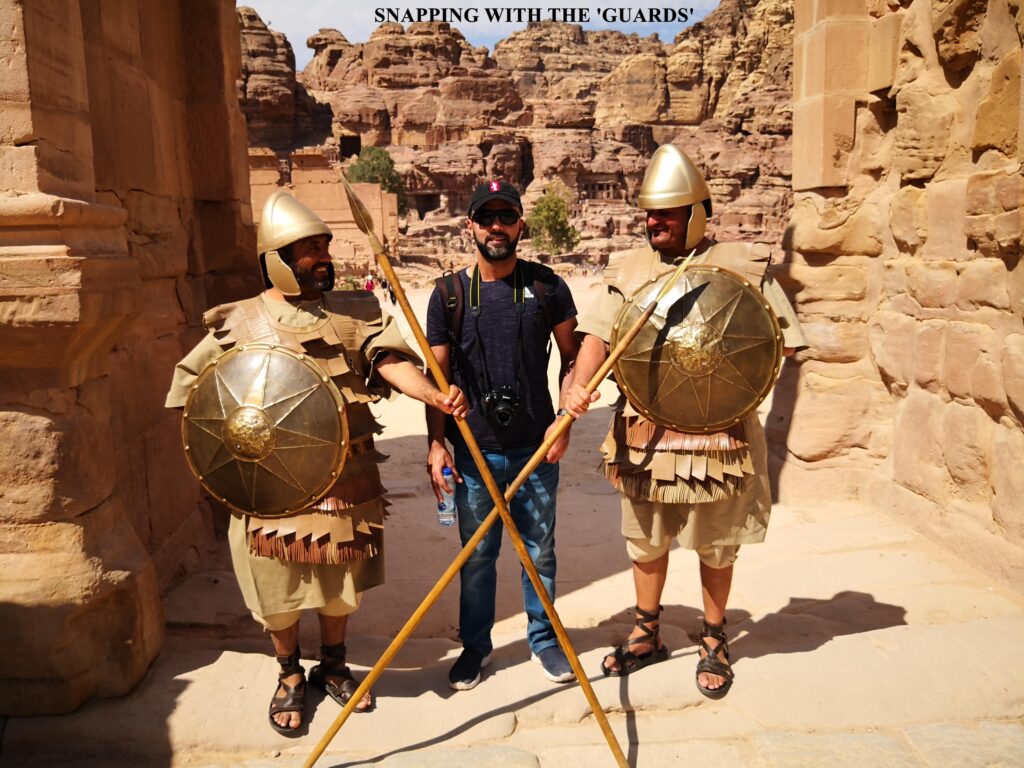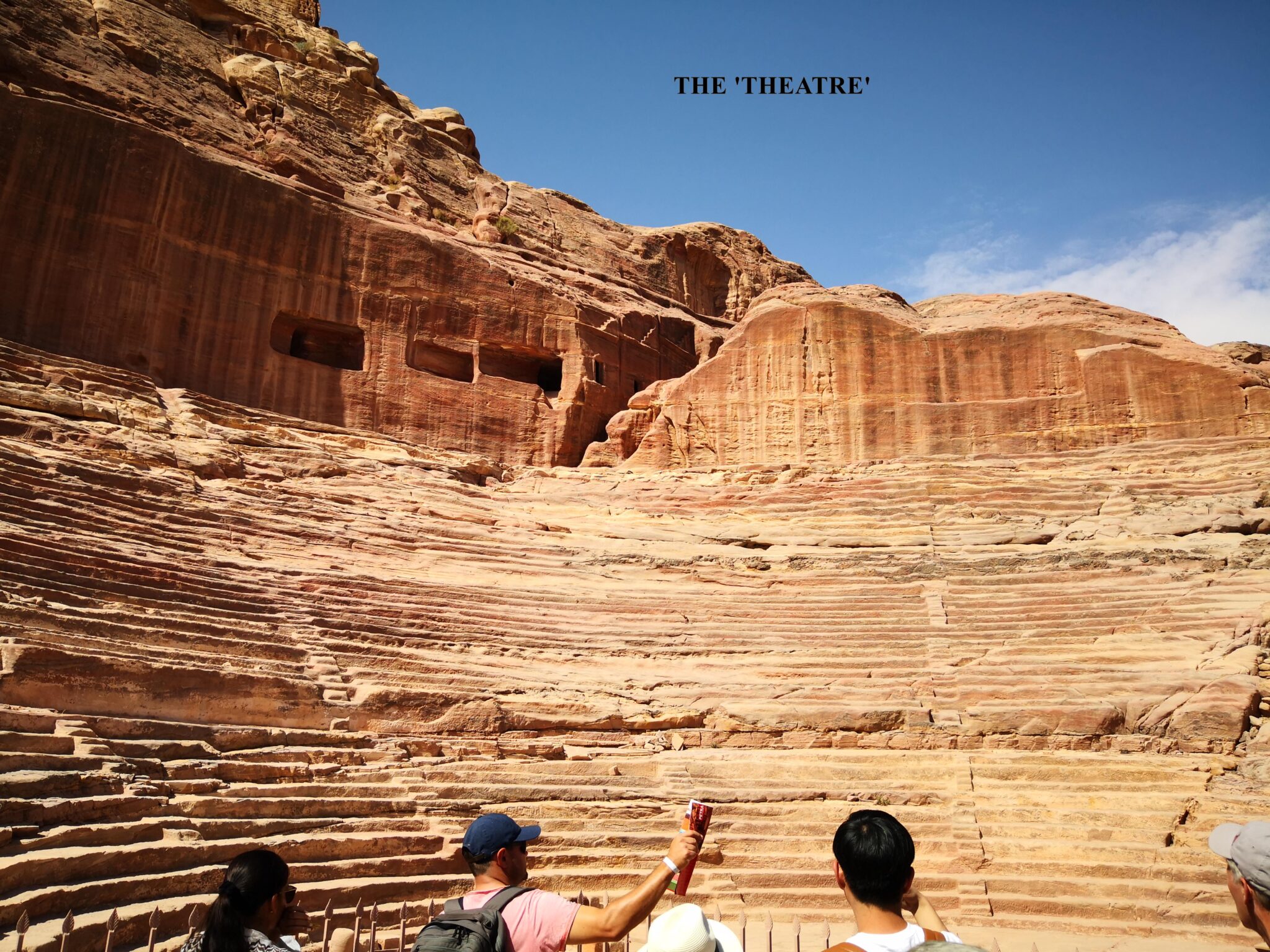Prologue
The ringing alarm went off, and I woke up startled yet realizing that I didn’t have time on my side; I got off the bed almost in a springy fashion and stood next to the hotel room window. Parting the heavy curtains, I could see twilight on the distant horizon. As nature painted colors on the canvas of sunrise in Amman, Jordan, I freshened up and double-checked my backpack. Water bottle, check, shades and pea cap, my camera gear, check.
I was to return to Riyadh that day after attending a conference over the preceding two days. Before embarking on the trip, I had already decided that even if I get the slightest time window, I would visit the archaeological remains of the city of Petra, which along with Al Hegra near the city of Madina in Saudi Arabia, are the footprints in the sands of time of the Nabatean Kingdom.

The Journey begins
A Medical Doctor fascinated by ancient history, the mysterious, and beyond, I took it upon myself to give Petra a visit since I had read about it and seen a lot of gorgeous photography. The previous evening, I had roamed around the hotel acquiring information as to the distance and time required for the Petra excursion ( though I had worked out the details before coming to Amman, the locals knew better). Learning enough Arabic to conversate with the locals was a plus. I made a done deal with a cab guy who was supposed to pick me up the following day before the break of dawn.
The Cab finally arrived, and after a brief chit-chat with the driver, we were on our way. It was still twilight, and I had left without having breakfast. It would take three-plus hours to reach our destination, and I had difficulty fighting off the drowsiness ( obviously without my cup of joe in the morning!). He assured me that he would make a pit stop as soon as he was on the main road outside Amman. And that he did, at a small tuck shop making coffee as well, to my delight.
A croissant to compliment the kick of the caffeine did the trick. Suddenly I was upright in the back seat. My mind was racing over what I came across at Petra, how grand it would be, and would I be able to see the whole thing and return in time for the flight back home. I also thought about which mentioned in the Holy Quran regarding the ‘Thamud’ civilization. It is purported to have been the very people of the Nabatean Kingdom.
It was explicitly mentioned about their mastery over building immense structures out of giant rocks and mountains and how they all came to a crashing halt. Snapping me out of my intellectual daze, the cabbie alerted me that our destination was near. It shows how time can be relative, passing by quickly when you are engrossed in something.
We reached the entrance of the ruins of Petra; the driver dropped me off at the entrance while giving me a pseudo-ultimatum of three hours to be out of the place since he said we wouldn’t be able to return to Amman in time. I walked to the ticketing office and got my pass as excited as ever ( after a few selfies at the gate, obviously!). I knew that the whole walk up the path to the city and back would roughly take 4 hours on a brisk foot ( 8 Km in total). I had to make it count and return in time.

The city structure of Petra and the Nabatean people
The Nabateans were Arabs who, in all likelihood, were nomads who originated from Southern Arabia and eventually settled in the area of present-day Southern Jordan, Palestine, and Northern/North-Western Arabia around the 6th century B. Some historians date the Nabatean Kingdom to have been established around mid of the 4th Century BC to 168 C.E when the Romans annexed it. Petra was the capital of the Kingdom.
As I could see, this area was in the middle of the desert, with extreme sun, aridness, and large red-colored mountains and rock formations. The Nabateans had these conditions to cope with; they were expert builders with exquisite engineering skills. They had the skills to pool and store water in underground water cisterns and aqueducts. This created a ready reserve of water in those times, and we all know how civilization and Kingdoms thrive around water bodies or even oases.
As I walked towards the security checkpoint, I ended up in a barren and dry expanse with a walking trail winding ahead. Raised rock formations eroded by the forces of nature and the passage of time on the sides of the walkway. After five or so minutes of trekking under the scorching October midday sun, huge red sandstone mountains loomed with a vertical break between the rock formations. The sheer size of these natural formations put me in awe.
The entrance through the mountains was marked ‘The Siq,’ which snaked its way through the enormous cliffs. I weighted my photography gear on my back while I kept taking photos. Cool air hugged my face and body as I walked through the twisting trail. This is expected when the shade under the rocks and temperature difference creates a cooling effect in such rock formations. On both sides of the snaking path were inscriptions, pottery, and artifacts neatly decorating the fringes.
Along these walls was evidence of depressions similar to water conduits which probably were aqueducts carrying water from outside the rock formations into the city for storage and use. Such productive use of nature’s creativity! As we talked along the continuing trail, I noticed that this was a city that was enclosed by a range of large, seemingly impenetrable mountains which served as fortification for the city.
So, the Siq, though nature’s work of art, served two purposes, first, protection and secondly, to channel water from outside the city from the surrounding city. Since the city of Petra is lower in elevation than the surroundings, this, combined with marvelous engineering, worked wonders in storing rainwater. I met a guy from South Sudan who was also busy taking shots. We exchanged pleasantries and shared our mutual interest in Photography & Ancient History.
As we reached the trail’s end, we could see a towering building through the wide slit. Reaching the spot, we were mesmerized by what appeared to be a magnificent pillared structure, the pillars so smooth, with symmetry between them. The finesse which had gone into making this was nothing short of spectacular. As my homework on the place served me well, this was the ‘Treasury’ or ‘Al- Khazneh’ as they call it, of the city.
The Nabateans were sharply skilled masons. They made immense structures out of sandstone, basically carving them out of the rock. It’s hard to believe structures like these were carved out more than a couple of millennia ago. These people had a definite structure to their society, with a Royal family ruling the city while the common folk during their assigned duties. There were practically no enslaved people.
The locals spoke a dialect of Arabic; however, one rarely finds inscriptions or records in Arabic in ruins. Most of their history, which has been transmitted, has been through the Greek and Roman historians. As we trekked along the trail, it opened up to a large plain with massive rock formations on the sides and tents, camels, and groups of people thronging the area. This was the ‘street of facades.’ Remains of tombs, and typical houses of people, were carved into the cliffs higher up on the sides.
There were tombs of the royals and the commoners. The royal tombs were built on the upper side of the cliffs while there were holes and caverns carved out below them. These are purported to be houses/tombs of the commoners. Flocks of people were gathered on the highest points of the sandstone cliffs to take photos and get a glimpse into these houses. There was a hustle of people in the central area of the plain, where there was a thriving marketplace—stalls selling souvenirs and trinkets, tuck shops selling drinks and snacks in the scorching heat.
Camels and mules with multicolored saddles; gave me a feel of what It would have been like back in the Kingdom’s hay day. There was a small ‘Theatre’ as in a Roman theater, with a semicircular theater which could probably seat 50 odd people. This was meant for public events or perhaps entertainment. The structures I had seen till now were reminiscent of Greek & Roman architecture. From around 2000 to 2400 years ago, the Greeks were thriving in the regions bordering the Kingdom, and the Romans annexed and settled in the area later on.


Religion and civil matters
The Nabatean society had special rights of equality for women. They rose to the position of Priestesses and had property rights and to co-rule. The idols of Allat, Manawaat, and Al-Uzza were female deities. They had attributed different responsibilities to a host of Gods.
The most enduring one is Dashura, the sun god. The inscriptions can be on coins even during the Roman tenure after they annexed the Kingdom. This is reflected in their practice of idol worship as well. They held public ( festivals ) but mostly private worship. The inscriptions and markings reflecting these deities can be seen in their tombs, on top of doorways and pottery.
My Pal and I scurried onwards and came across a freestanding structure (the largest freestanding structure in the city ), tall and partially intact. It was called ‘Qasr-bint.’ It was the city’s main temple, and the idol deity Dushura was worshipped here. The temple is made of blocks with decorative plasterwork on both the inside and outsides of the walls. Strings of wood course between the blocks and line the walls. This was quite intricate civil engineering.
We came across this sizeable staired structure with an endless number of steps to the top where numerous bases of pillars could be seen in a row. It was a temple. Again, it probably served ceremonial and religious purposes. The remains of the pillars remind us of how grand the structure would have been. I went up there and spent a few minutes carrying on with my newfound pal.
A few men dressed as Nabatean guards were standing near an entrance of sorts along the path. This looked like a check post which would have served the purpose of security for what lay ahead. The men wore an imitation of armor and helmets and were wielding spears. They gleefully posed for photos with us!

Nabatean Trade and Wealth
Further hurrying down the trail, we found makeshift shops and permanent ones selling some stuff in large bowls. On closer inspection, it was a wide colorful range of spices and frankincense (aromatic extracts from particular tree bark). Frankincense has been used and traded for millennia. It is burnt, and the aroma, which is earthy, sweet, and musky, is said to purify the surroundings and calm your soul. The Nabatean Kingdom’s primary revenue was generated from the trade route extended from the Yemeni coast in Southern Arabia to the dead and Mediterranean seas.
This route enabled them to do business and interact with the civilizations bordering them. Namely the Greeks, Romans, Persians, and Assyrians. They had exclusivity to this trade. The returns came in thick and fast, which enabled the Kingdom to flourish by leaps and bounds. They had an outpost called Al Hegra which in present-day is around 350 km from the Holy City of Madina. The output served as a pitstop for the trading caravans. Al Hegra also had a thriving population. The tombs and houses carved out of sandstone rock can still be seen standing amidst the barren desert.
The success of their trade and immense wealth were reasons for envy for the neighboring Greeks, with numerous attempts made to capture parts of the route; however, they were warded off by the Nabateans. Demetrius, son of the Greek King, Antigonus I, tried to raid the city in 312 B.C but failed and, in a later encounter, suffered the same fate again.

The collapse of the Nabatean Civilization and epilogue
To my respite, we ended up near the entrance of the city of Petra. I bought a few souvenirs from the market, walked towards the taxi stand, turned back, and gave it one last look. Realize how Civilizations and Kingdoms flourish with such majestic skills and wealth and how they eventually fall. They went to war many times with the Greeks in skirmishes which they finally won, but they were no match for the invading Romans at the turn of the common era ( C.E ).
Numerous Nabatean Kings succeeded each other. However, considered to be their greatest King was Arteus IV, reigning from 9 B.C to 40 C.E. Under him, the Nabateans regained territory from the Romans. The latter had captured it in earlier confrontations. Art, crafts, and civil rights all flourished during his reign. However, the kings succeeding him lost more territory to the Romans, and eventually, the Kingdom weakened, and wealth dwindled due to the loss of trade routes.
The Roman empire was growing in power simultaneously and eventually annexed the region as the Roman Province of Arabia Petra in 106 C.E. The cities under Roman rule went into a downward spiral. However, a devastating earthquake shook the cities in probably the later half of the 4th century C.E. This was the final nail in the coffin. Many died along with the loss of infrastructure. The Roman Empire tried to resurrect the city’s spirit by re-igniting commerce and building churches. It said that they forcibly tried to convert many locals to Christianity.
Many probably fled the area with no sense of ownership and religious persecution. Another earthquake struck the region in the 6th century C.E. This led to widespread destruction and eventually abandonment of the cities. This is further confirmed when during the expansion of the Islamic Empire during the region of Caliph Umar, the Muslim armies found these cities deserted and forlorn. European explorers discovered the region in the 19th and 20th centuries, and the world was exposed to these magnificent ruins. The city was declared World Heritage in 1985 and one of the 7 New Wonders of the World in 2007.
I got into the cab and went on my way to the Hotel in Amman city center. What I witnessed was a testimony to how Civilizations rise to power no matter their status, prowess, or grandeur. All are swept away by the relentless flow of time. The remains of their presence are an eye-opener for us of how fragile we are.
Read more articles in our archaeology edition in the archives.

Dr Syed Hunain Riaz is a Physician with expertise and experience in Endocrinology & Metabolism with a passion for eliciting change through the dissemination and application of precise knowledge. He is a space enthusiast, avid reader, blog writer, amateur photographer ( Astro & every day), and gamer.
Writing interests include preventive & lifestyle medicine and psychosocial issues. Dr. Hunain believes in limitless creativity and productivity of the human mind. Nature of consciousness, reality, and patterns in the universe are areas of special interest. He can be reached at syedhunain@gmail.com

